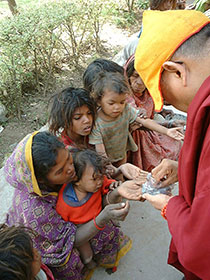- Home
- FPMT Homepage
Foundation for the Preservation of the Mahayana Tradition
The FPMT is an organization devoted to preserving and spreading Mahayana Buddhism worldwide by creating opportunities to listen, reflect, meditate, practice and actualize the unmistaken teachings of the Buddha and based on that experience spreading the Dharma to sentient beings. We provide integrated education through which people’s minds and hearts can be transformed into their highest potential for the benefit of others, inspired by an attitude of universal responsibility and service. We are committed to creating harmonious environments and helping all beings develop their full potential of infinite wisdom and compassion. Our organization is based on the Buddhist tradition of Lama Tsongkhapa of Tibet as taught to us by our founders Lama Thubten Yeshe and Lama Thubten Zopa Rinpoche.
- Willkommen
Die Stiftung zur Erhaltung der Mahayana Tradition (FPMT) ist eine Organisation, die sich weltweit für die Erhaltung und Verbreitung des Mahayana-Buddhismus einsetzt, indem sie Möglichkeiten schafft, den makellosen Lehren des Buddha zuzuhören, über sie zur reflektieren und zu meditieren und auf der Grundlage dieser Erfahrung das Dharma unter den Lebewesen zu verbreiten.
Wir bieten integrierte Schulungswege an, durch denen der Geist und das Herz der Menschen in ihr höchstes Potential verwandelt werden zum Wohl der anderen – inspiriert durch eine Haltung der universellen Verantwortung und dem Wunsch zu dienen. Wir haben uns verpflichtet, harmonische Umgebungen zu schaffen und allen Wesen zu helfen, ihr volles Potenzial unendlicher Weisheit und grenzenlosen Mitgefühls zu verwirklichen.
Unsere Organisation basiert auf der buddhistischen Tradition von Lama Tsongkhapa von Tibet, so wie sie uns von unseren Gründern Lama Thubten Yeshe und Lama Thubten Zopa Rinpoche gelehrt wird.
- Bienvenidos
La Fundación para la preservación de la tradición Mahayana (FPMT) es una organización que se dedica a preservar y difundir el budismo Mahayana en todo el mundo, creando oportunidades para escuchar, reflexionar, meditar, practicar y actualizar las enseñanzas inconfundibles de Buda y en base a esa experiencia difundir el Dharma a los seres.
Proporcionamos una educación integrada a través de la cual las mentes y los corazones de las personas se pueden transformar en su mayor potencial para el beneficio de los demás, inspirados por una actitud de responsabilidad y servicio universales. Estamos comprometidos a crear ambientes armoniosos y ayudar a todos los seres a desarrollar todo su potencial de infinita sabiduría y compasión.
Nuestra organización se basa en la tradición budista de Lama Tsongkhapa del Tíbet como nos lo enseñaron nuestros fundadores Lama Thubten Yeshe y Lama Zopa Rinpoche.
A continuación puede ver una lista de los centros y sus páginas web en su lengua preferida.
- Bienvenue
L’organisation de la FPMT a pour vocation la préservation et la diffusion du bouddhisme du mahayana dans le monde entier. Elle offre l’opportunité d’écouter, de réfléchir, de méditer, de pratiquer et de réaliser les enseignements excellents du Bouddha, pour ensuite transmettre le Dharma à tous les êtres. Nous proposons une formation intégrée grâce à laquelle le cœur et l’esprit de chacun peuvent accomplir leur potentiel le plus élevé pour le bien d’autrui, inspirés par le sens du service et une responsabilité universelle. Nous nous engageons à créer un environnement harmonieux et à aider tous les êtres à épanouir leur potentiel illimité de compassion et de sagesse. Notre organisation s’appuie sur la tradition guéloukpa de Lama Tsongkhapa du Tibet, telle qu’elle a été enseignée par nos fondateurs Lama Thoubtèn Yéshé et Lama Zopa Rinpoché.
Visitez le site de notre Editions Mahayana pour les traductions, conseils et nouvelles du Bureau international en français.
Voici une liste de centres et de leurs sites dans votre langue préférée
- Benvenuto
L’FPMT è un organizzazione il cui scopo è preservare e diffondere il Buddhismo Mahayana nel mondo, creando occasioni di ascolto, riflessione, meditazione e pratica dei perfetti insegnamenti del Buddha, al fine di attualizzare e diffondere il Dharma fra tutti gli esseri senzienti.
Offriamo un’educazione integrata, che può trasformare la mente e i cuori delle persone nel loro massimo potenziale, per il beneficio di tutti gli esseri, ispirati da un’attitudine di responsabilità universale e di servizio.
Il nostro obiettivo è quello di creare contesti armoniosi e aiutare tutti gli esseri a sviluppare in modo completo le proprie potenzialità di infinita saggezza e compassione.
La nostra organizzazione si basa sulla tradizione buddhista di Lama Tsongkhapa del Tibet, così come ci è stata insegnata dai nostri fondatori Lama Thubten Yeshe e Lama Zopa Rinpoche.
Di seguito potete trovare un elenco dei centri e dei loro siti nella lingua da voi prescelta.
- 欢迎 / 歡迎
简体中文
“护持大乘法脉基金会”( 英文简称:FPMT。全名:Foundation for the Preservation of the Mahayana Tradition) 是一个致力于护持和弘扬大乘佛法的国际佛教组织。我们提供听闻,思维,禅修,修行和实证佛陀无误教法的机会,以便让一切众生都能够享受佛法的指引和滋润。
我们全力创造和谐融洽的环境, 为人们提供解行并重的完整佛法教育,以便启发内在的环宇悲心及责任心,并开发内心所蕴藏的巨大潜能 — 无限的智慧与悲心 — 以便利益和服务一切有情。
FPMT的创办人是图腾耶喜喇嘛和喇嘛梭巴仁波切。我们所修习的是由两位上师所教导的,西藏喀巴大师的佛法传承。
繁體中文
護持大乘法脈基金會”( 英文簡稱:FPMT。全名:Found
ation for the Preservation of the Mahayana Tradition ) 是一個致力於護持和弘揚大乘佛法的國際佛教組織。我們提供聽聞, 思維,禪修,修行和實證佛陀無誤教法的機會,以便讓一切眾生都能 夠享受佛法的指引和滋潤。 我們全力創造和諧融洽的環境,
為人們提供解行並重的完整佛法教育,以便啟發內在的環宇悲心及責 任心,並開發內心所蘊藏的巨大潛能 — 無限的智慧與悲心 – – 以便利益和服務一切有情。 FPMT的創辦人是圖騰耶喜喇嘛和喇嘛梭巴仁波切。
我們所修習的是由兩位上師所教導的,西藏喀巴大師的佛法傳承。 察看道场信息:
- FPMT Homepage
- News/Media
-
- Study & Practice
-
-
- About FPMT Education Services
- Latest News
- Programs
- New to Buddhism?
- Buddhist Mind Science: Activating Your Potential
- Heart Advice for Death and Dying
- Discovering Buddhism
- Living in the Path
- Exploring Buddhism
- FPMT Basic Program
- FPMT Masters Program
- FPMT In-Depth Meditation Training
- Maitripa College
- Lotsawa Rinchen Zangpo Translator Program
- Universal Education for Compassion & Wisdom
- Online Learning Center
-
- Prayers & Practice Materials
- Overview of Prayers & Practices
- Full Catalogue of Prayers & Practice Materials
- Explore Popular Topics
- Benefiting Animals
- Chenrezig Resources
- Death & Dying Resources
- Lama Chopa (Guru Puja)
- Lama Zopa Rinpoche: Compendium of Precious Instructions
- Lama Zopa Rinpoche: Life Practice Advice
- Lama Zopa Rinpoche Practice Series
- Lamrim Resources
- Mantras
- Prayer Book Updates
- Purification Practices
- Sutras
- Thought Transformation (Lojong)
- Audio Materials
- Dharma Dates - Tibetan Calendar
- Translation Services
- Publishing Services
- Ways to Offer Support
- Prayers & Practice Materials
-
- Teachings and Advice
- Find Teachings and Advice
- Lama Zopa Rinpoche Advice Page
- Lama Zopa Rinpoche: Compendium of Precious Instructions
- Lama Zopa Rinpoche Video Teachings
- ༧སྐྱབས་རྗེ་བཟོད་པ་རིན་པོ་ཆེ་མཆོག་ནས་སྩལ་བའི་བཀའ་སློབ་བརྙན་འཕྲིན།
- Podcasts
- Lama Yeshe Wisdom Archive
- Buddhism FAQ
- Dharma for Young People
- Resources on Holy Objects
- Teachings and Advice
-
-
*If a menu item has a submenu clicking once will expand the menu clicking twice will open the page.
-
-
- Centers
-
- Teachers
-
- Projects
-
-
-
-
*If a menu item has a submenu clicking once will expand the menu clicking twice will open the page.
-
-
- FPMT
-
-
-
-
-
Most of the time our grasping at and craving for worldly pleasure does not give us satisfaction. It leads to more dissatisfaction and to psychologically crazier reactions.
Lama Thubten Yeshe
-
-
-
- Shop
-
-
-
The Foundation Store is FPMT’s online shop and features a vast selection of Buddhist study and practice materials written or recommended by our lineage gurus. These items include homestudy programs, prayers and practices in PDF or eBook format, materials for children, and other resources to support practitioners.
Items displayed in the shop are made available for Dharma practice and educational purposes, and never for the purpose of profiting from their sale. Please read FPMT Foundation Store Policy Regarding Dharma Items for more information.
-
-
Mandala
3
Making Peace with Our Inner Family

Illustration by Claudia Wellnitz
“Sometimes I meet Buddhists who seem to consider it a waste of time, despite the teachings, to look at the way their own selves are constructed, or study their personal psychological make-up,” writes Claudia Wellnitz, a student of Lama Yeshe and Lama Zopa Rinpoche since 1980, and who has studied Buddhist psychology, philosophy and Buddhist-based psychotherapy. “Personally I find that borrowing from some Western psychological models can help us to understand more thoroughly what our meditations should be directed at.”
“Many years of exposure to the Dharma or mere scholarship alone don’t guarantee that people will become more balanced and happy, or that their behavior towards others will improve. Sometimes it seems as if the very thing that was made to liberate beings is being used as an instrument to have power over others or harden people’s neurotic ego-structures. People – and I include myself – who have the best of intentions, who so much long to be like saints, fall prey again and again to power trips, fits of jealousy or anger, and create disasters in personal relationships. Often consciously declared intentions, and the things people do, seem to be many hundreds of miles apart. And merely remembering the rules of Buddhist ethics alone doesn’t help: The energies dominating the person are too strong.”
30
Working with the Western Mind
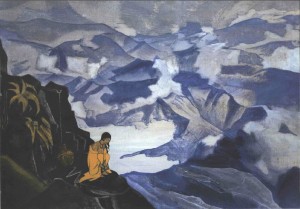
“Drops of Life,” Nicholas Roerich Museum, used with permission.
While on a three-year retreat, Lama Palden Drolma began to see that psychological methods could be helpful for Western Dharma practitioners. Some years later, she became a licensed psychotherapist. She speaks to Jaffa Elias about integrating her work with her experience of teaching, studying and practicing Dharma.
Through Dharma study and practice, the path to complete liberation, we begin by realizing that we are never going to be satisfied through dependence on phenomena – other people, our homes, jobs, body, etc. – as they are impermanent and not ultimately capable of giving us refuge. It is only the Three Jewels that are capable of giving us refuge.
As practitioners we often come up against our own negative habitual patterns. Many varieties of Dharma practice are designed to help us purify and release these patterns. At the same time, the psychological practice of direct inquiry into our conflicting emotions could also be helpful. Some people have the good karma to work with obscurations purely from a Dharma perspective, but many of us need to look at these things psychologically, find out what’s going on and try to unravel it. If our emotional turmoil and/or behaviors are not getting transformed through our practice, it means that there’s some kind of big knot around which some psychological work may be needed….
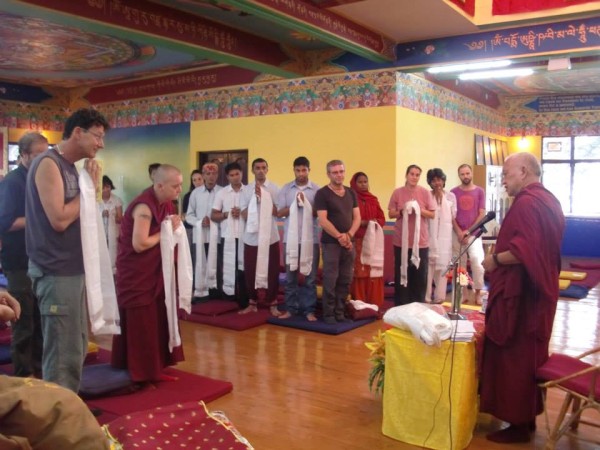
Lama Zopa Rinpoche thanks Tushita Meditation Centre staff and volunteers, May 25, 2013. Photo courtesy of Tushita Meditation Centre via Facebook.
Lama Zopa Rinpoche spent Saka Dawa, May 25, at Tushita Meditation Centre in Dharamsala, India, engaging in a variety of virtuous activities. In addition to feeding the monkeys that live in the area and extensive blessings for Tushita’s three dogs – Nying-je Chenmo (Great Compassion), Yeshe (Wisdom) and Dekyi (Happiness) – Rinpoche gathered staff and volunteers together in Tushita’s newly painted gompa to thank them for their service.

Lama Zopa Rinpoche blesses Tushita’s dogs, May 25, 2013. Photo courtesy of Tushita Meditation Centre via Facebook.
“Your service is amazing,” Rinpoche told the group. “Doing so much for sentient beings!”
Tushita Meditation Centre is an active FPMT center in McLeod Ganj village, seat of the Tibetan government-in-exile. You can find more photos of the center’s activities, including a Chenrezig initiation with Denma Locho Rinpoche, Glen Svensson’s introductory Buddhist course, and a recently completed set of nyung näs, on Facebook.
- Tagged: lama zopa rinpoche, mandala, tushita meditation centre
- 0
24
Life Among the Mount Everest Centre Monks
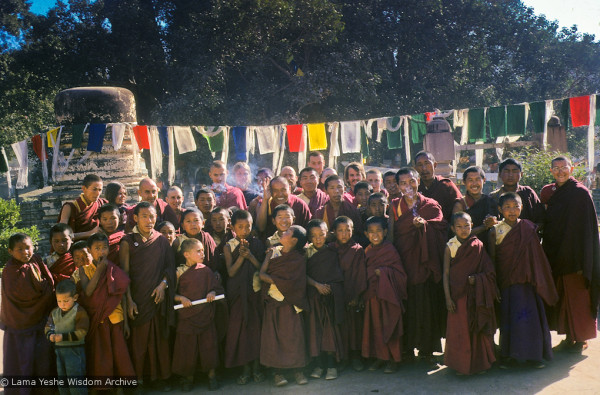
Mount Everest Centre students in Bodhgaya, India, 1974. Photo courtesy of Lama Yeshe Wisdom Archive.
One of FPMT founders Lama Yeshe’s and Lama Zopa Rinpoche’s earliest projects was to support and educate the monks of Mount Everest Centre, a group of local boys from Lawudo, Nepal, that later moved down from the high Himalayas to Kopan in the early 1970s, impelled by the harsh climate. Others would later join this group, such as the Western boy Michael Losang Yeshe, who asked to stay at Kopan when he was six.
Adele Hulse records some of Michael’s and his peer’s experiences at Kopan in Big Love, the forthcoming biography of FPMT founder Lama Yeshe. Lama Yeshe Wisdom Archive will publish Big Love later this year and has been sharing excerpts from the book on their Big Love blog. The following is from a recent post:
By 1974 Michael Losang Yeshe, then nine, had spent almost half his life at Kopan. Olivia, his mother, now lived in Japan. One day Michael received a parcel from her. “Lama Yeshe heard about it and came to my room,” said Michael. “‘Where is the parcel?’ he asked. ‘Open it.’ He looked inside and handed me a set of colored pencils. ‘These colors, these are for everyone, not just you.’ He pulled out a shirt and underwear. ‘These you can wear.’ Then he saw the fancy Mickey Mouse watch. ‘You’re too young for a watch; you don’t know how to tell time. This for me. I keep for you.’ If I had kept it, I would only have lost it, or traded it for comics or something a few days later. He never did give it back,” said Michael.
Very occasionally the boys were given cash offerings at pujas. When Michael’s father, Yorgo, married a Nepali woman and moved to Kathmandu, he sponsored a big puja at his house. All the boys there received 100 rupees each. When they returned to Kopan Lama took all the rupees from them. They didn’t need money – Kopan did. Yorgo also donated buffaloes to Kopan so the monastery wouldn’t have to buy milk, and he often drove Lama around town on errands.
Lama Yeshe could shift at the drop of a hat from acting the clown to being extremely wrathful. Every inch the abbot, he would walk up and down the rows of small boys in the gompa, making sure they paid attention and not hesitating to discipline them with judicious use of his heavy mala where required.
“I was a naughty one,” said Tenzin Dorje Rinpoche, also known as Charok Lama. “I was lazy and he beat me on the shoulders with his big mala or with a stick. The big wooden malas really hurt. Many boys cried when Lama hit. The Western view is that hitting is bad, but Lama’s motivation and his way of hitting were different. Somehow I was always happy after he hit me. Of course, there were some boys who really didn’t want to be in the monastery and who didn’t like Lama either. But Lama always told us to have an open ear, to listen to everyone for a good education. That way we would develop bigger ideas, which are more beneficial.”…
Read the entire post by Adele Hulse on the Big Love blog.
- Tagged: adele hulse, big love, mandala, michael losang yeshe
- 0
22
How a Guru Becomes a Powerful Object of Merit
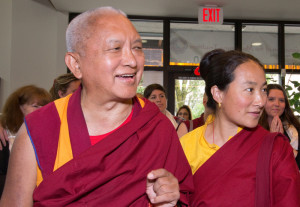
Lama Zopa Rinpoche and Khadro-la, FPMT International Office, Portland, Oregon, USA, June 2012. Photo by Marc Sakamoto.
At the end of April, Rangjung Neljorma Khadro Namsel Drönme (Khadro-la) advised FPMT centers, projects, services and students to engage in specific practices and activities “as much as possible” to support Lama Zopa Rinpoche’s health, including offering Long Life Pujas with the Five Dakinis.
At a 2006 long life puja at Chenrezig Institute, Rinpoche reiterated how a guru becomes a powerful object of merit (or as Rinpoche says, a “powerful one”):
… That means there’s no question any time that by offering to the guru then you collect more merit than having made offerings to numberless Buddha, Dharma, Sangha; numberless statues, stupas, scriptures. [It’s the same] even making offering to the “pores” of the guru. Why? Because the object is more powerful than numberless buddhas.
The power is a dependent-arising. Why the guru is more powerful, most powerful, is a dependent-arising; it’s not independent, that power’s not independent, not truly existent. The minute when you have taken a Dharma connection, even a few syllables of mantra, oral transmission or received two or three verses of teaching with the recognition that oneself is a disciple and that [person] is the guru, then the other person, due to this, becomes the most powerful one in one’s own life, [even] more than any of all those other powerful ones, starting from the parents of this life.
In addition to the long life pujas organized by FPMT centers around the world, students can support the FPMT Long Life Puja Fund which arranges long life pujas for His Holiness the Dalai Lama and Rinpoche annually.
If you like what you read on Mandala, consider becoming a Friend of FPMT, which supports our work. Friends of FPMT at the Basic level and higher receive the print magazine Mandala, delivered quarterly to their homes.
- Tagged: khandro kunga bhuma, lama zopa rinpoche, long life puja fund, mandala, teac
- 0
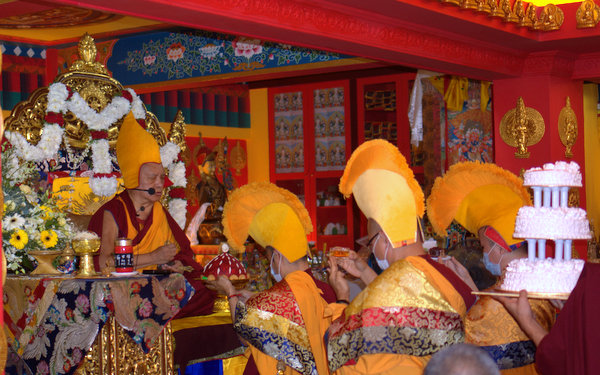
Long life puja for Lama Zopa Rinpoche at Losang Dragpa Centre, Malaysia, March 17, 2013. Photo by Bill Kane.
In April 2013, Lama Zopa Rinpoche and the Lama Zopa Rinpoche Bodhichitta Fund offered US$65,187 to the FPMT Puja Fund, which sponsors ongoing pujas at the great monasteries in India and Nepal, with over 9,000 Sangha participating. All the pujas are dedicated for the long life of His Holiness the Dalai Lama, and to the success of all FPMT centers, projects, students, benefactors and those serving the organization in any way.
For Saka Dawa (this year, May 25), the Puja Fund offers the following:
- Tukchuma Puja, 64 Offerings to Kalarupa, Medicine Buddha Puja at Kopan Monastery, Nepal
- 100,000 recitations of the Praises to the 21 Taras and offerings to Sangha at Kopan Monastery and Khachoe Ghakyil Nunnery, Nepal
- Offerings to all of Lama Zopa Rinpoche’s gurus
- Offerings are made to all the Sangha at international Sangha communities
- 16 Nyung Nä cycles and offering to the nuns at Potawa Nunnery, Tibet
- Making and filling of stupas and lunch offering to participants at Chenrezig Institute, Australia
- White wash and four giant saffron flower petals are offered to Bouddhanath and Swayambunath stupas in Nepal, as well as offering new umbrellas to the stupas’ pinnacles
- A new set of robes of the most precious material is offered to the Buddha inside the Bodhgaya Mahabodhi temple as well as the Jowo Buddha in Lhasa’s Jokang and also gold is offered to the holy face of the Jowo Buddha
Some of the offerings to the Puja Fund were accumulated from what was offered to Lama Zopa Rinpoche at the recent long life pujas in Singapore and Taiwan while on tour in Southeast Asia February through March. A long life puja was also offered to Rinpoche by more than 500 students in Malaysia.
You can read more about the FPMT Puja Fund online and in a recent article in Mandala April-June 2013.
If you like what you read on Mandala, consider becoming a Friend of FPMT, which supports our work. Friends of FPMT at the Basic level and higher receive the print magazine Mandala, delivered quarterly to their homes.
17
What Will You Do on Saka Dawa, May 25?

Lama Zopa Rinpoche reading texts while on his exercise bike in Washington State, USA.
On May 25, FPMT celebrates Saka Dawa, one of the four great holy days of the Tibetan calendar, which commemorates the Buddha’s birth, death, and parinirvana. FPMT centers, projects, services and students around the world will engage in virtuous activities – such as taking the Eight Mahayana Precepts, completing nyung näs, and performing Guru Shakyamuni Buddha puja – recommended by Lama Zopa Rinpoche. Rinpoche frequently mentions that on great holy days such as Saka Dawa, the merit generated by any wholesome activity is multiplied 100 million times.
FPMT International Office participates in the global Saka Dawa activities by honoring and supporting Lama Zopa Rinpoche’s tireless work for others through the annual Work a Day for Rinpoche campaign. Students and supporters of Rinpoche are encouraged to donate part of their salary earned on Saka Dawa (or visualize making an extensive offering) and recite the Sutra of Golden Light for Rinpoche’s health and long life.
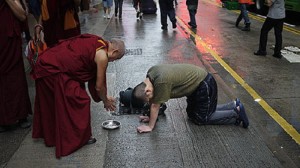
Lama Zopa Rinpoche making offerings to a person in the streets of Hong Kong, 2010.
“When you’re with Rinpoche, the word ‘work’ takes on a whole new meaning,” shares Work a Day for Rinpoche coordinator Justin Jenkins. “I once saw Rinpoche teach for 14 hours straight and immediately after travel to the mountains to do hours of prayers by a lake. I’m happy to coordinate Work a Day for Rinpoche, which is part of my own way of working for Rinpoche and celebrating Saka Dawa.”
Funds from the Work a Day for Rinpoche campaign go to FPMT International Office, which works to support Rinpoche’s vast vision. Your offering benefits the creation of education programs and practice materials; aids all of FPMT’s charitable projects; supports Dharma centers, projects and services; sustains the vast resources on the FPMT website; and more.
- Tagged: mandala, saka dawa, work a day for rinpoche
- 0
11
10,000 Khatas for His Holiness the Dalai Lama
His Holiness the Dalai Lama spoke for a third day in Portland, Oregon, as part of Maitripa College’s Environmental Summit. During the Saturday morning panel discussion, His Holiness shared the stage with Oregon Governor John Kitzhaber, scientists and environmental activist David Suzuki, and Andrea Durbin of the Oregon Environmental Council. During the afternoon, His Holiness spoke on compassion. He closed his talk saying, “Warmheartedness is the key to a happy life.”
The event with His Holiness concluded with the 10,000 audience members offering khatas to His Holiness. Then His Holiness commented on the significance of the offering scarves and praised Maitripa College President Yangsi Rinpoche, who was responsible for inviting His Holiness to Portland and hosting the summit.
Maitripa College is affiliated with FPMT. Saturday’s events follow His Holiness’ visit to Maitripa College and FPMT International Office on Friday. On Sunday, May 12, Maitripa College has organized a Green Action Day at Portland’s Pioneer Square, featuring national environmental leaders, local bands and a Tibetan prayer flag hanging ceremony.
You can find all the news and coverage of the Environmental Summit online. Visit His Holiness’ website for news on all of His Holiness’ events and travels. Mandala will continue to cover the events of the summit on our blog, Twitter and in the next issue of Mandala.
If you like what you read on Mandala, consider becoming a Friend of FPMT, which supports our work. Friends of FPMT at the Basic level and higher receive the print magazine Mandala, delivered quarterly to their homes.
- Tagged: his holiness the dalai lama, maitripa college, mandala
- 0
3

His Holiness the Dalai Lama, Bodhgaya, 1974. Image courtesy of Lama Yeshe Wisdom Archive.
“In January 1974 His Holiness the Dalai Lama bestowed the Kalachakra (Wheel of Time) initiation for the fifth time in his life, and the third since leaving Tibet,” writes Adele Hulse, author of Big Love, the forthcoming biography of FPMT founder Lama Thubten Yeshe. Lama Yeshe Wisdom Archive will publish Big Love later this year and has been sharing excerpts from the book on their Big Love blog. The following is from a recent post:
The profound Kalachakra Tantra, a pathway to full enlightenment, contains elements of astrology, medicine, and mathematics. Over 100,000 Tibetans descended on Bodhgaya. They came by train, bus, rickshaw, and on foot from many places inside and outside India: Dharamsala, Darjeeling, Dalhousie, Mysore, and Bangalore; from Ladakh, Bhutan, Sikkim, Nepal, and Tibet, many of them wearing local costumes and jewelry. Tent cities sprang up with bustling restaurants serving all types of Tibetan and Indian food — momos (Tibetan meat dumplings), thukpa (Tibetan meat stew), samosas, chai, and the like — alongside market stalls selling clothes, religious objects, and antiques. It was a scene out of National Geographic magazine.
Several hundred Westerners also poured into Bodhgaya for the initiation. Many of them stayed in the Tibetan tent-restaurants, which allowed people to sleep on the wide benches at night. The hippies in their motley garb mixed easily with the wild folk from the mountains, the men in sheepskin trousers, their long plaits woven with red ribbon. For many Tibetans it was their first sight of the Dalai Lama. They prostrated and cried loudly. All day and all night pilgrims circumambulated the Mahabodhi stupa on its three different walkways, many prostrating all the way around.
Everybody at Kopan who could get to Bodhgaya went there. When asked to explain the Kalachakra initiation, Lama Yeshe became very serious, telling the students this was not something they should take lightly. …
Read the entire post by Adele Hulse — which includes Lama Yeshe’s teaching to Westerners in preparation for the initiation — on the Big Love blog.
- Tagged: big love, his holiness the dalai lama, kalachakra, lama yeshe, mandala
- 0
2
The Path of Awakening
FPMT News Around the World

Bedsa Cave, India. Photo: Martine Batchelor via Aeon Magazine.
Mandala’s April-June issue explores the path of pilgrimage. In it, we offer readers many original stories and accounts of pilgrimage sites in Tibet, India, Nepal and China. In a recent essay, Buddhist writer Martine Batchelor describes holy sites in India that are mostly unknown to and rarely visited by Western pilgrims. Martine’s inspiring piece compliments our pilgrimage coverage and shares some of the fascinating history of these sites. Her journey with 30 other practitioners included visits to Maharashtra, Kanheri, Karla, Bedsa Caves, Pandulena, Ajanta and Ellora, Pitalkhora and the great stupa of Sanchi.
Martine writes:
Kanheri became dear to my heart, a haven of caves with few icons, its simplicity deeply evocative of early monastic life. There were many small carved stone huts: monastic cells with one or two stone beds and light coming from small windows punched into the walls. Outside each cell was a small cistern for water, which was fed by an intricate system of underground run-off. An elegant stone bench to the side completed the set-up – for the view, as a place to rest in the heat, for interviews, or for all three: who knows? It was easy to imagine myself as one of the monks or nuns meditating, chanting or studying, or as a layperson visiting them for inspiration and encouragement. Here one did not feel a convert to a strange exotic religion but a practitioner of a path, a culture of awakening.
Read Martine Batchelor’s complete article “In Whose Footsteps?” online at Aeon Magazine. For a complete collection of Mandala articles old and new on pilgrimage, look through our pages tagged “pilgrimage.”
If you’d like to receive the next issue of Mandala magazine, become a Friend of FPMT. Mandala is a benefit of the Friends of FPMT program and supports the work of FPMT International Office, which is dedicated to supporting the fulfillment of all the wishes of Lama Zopa Rinpoche and His Holiness the Dalai Lama.
- Tagged: mandala, martine batchelor
- 0
29
Long Life Practice for Lama Zopa Rinpoche at Maratika Caves
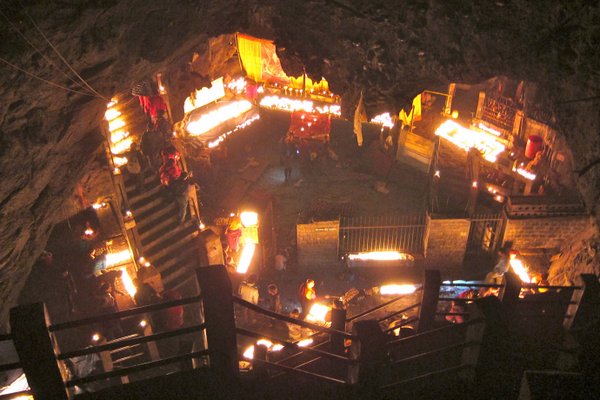
Butter lamp offerings alight the main cave at Maratika during the first four days of Losar, Nepal, February 2013. Photo by Ven. Sarah Thresher.
For Losar 2013, Ven. Sarah Thresher was able to travel to the Maratika Caves, a powerful holy site in Nepal, where she made numerous prayers and light offerings for Lama Zopa Rinpoche’s long life, health and the fulfillment of all of Rinpoche’s holy wishes. Due to the generosity of sponsors, Ven. Sarah was able to stay three weeks. She kindly shared a report on her pilgrimage with Mandala, which we present here in a shortened form.
By Ven. Sarah Thresher
According to the wisdom tradition, Maratika is one of the six holiest places in the world. It is said that long ago Maratika was blessed by the three types of buddhas ‒ Manjushri, Chenrezig and Vajrapani ‒ and there are still three hills there which bear their names. Clearly visible in the rock and soil are the white, red and blue colors that represent each buddha.
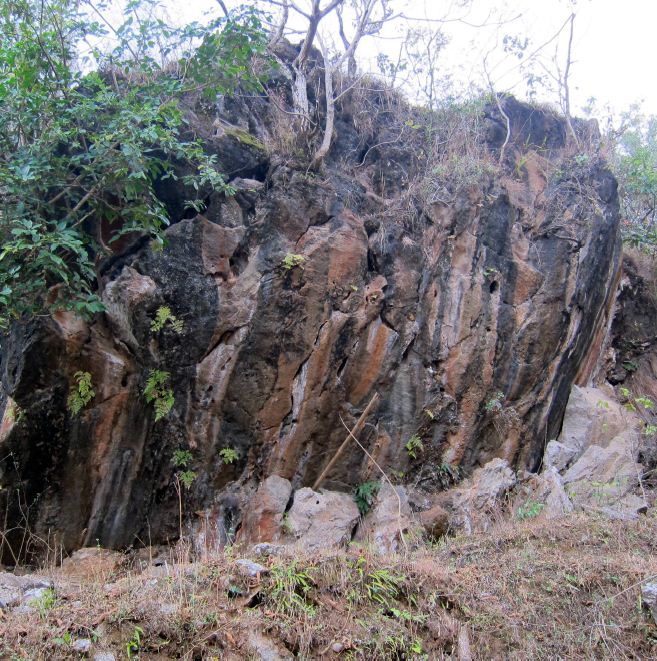
Three colors of the three types of buddhas visible in Vajrapani Hill. Photo by Ven. Sarah Thresher.
There are also five holy caves with many naturally arising (rang jung) special features ‒ such as a natural conch in the wrathful cave, victory banners and pennants hanging from the roof of the caves, dakini script on the walls, a phurba, a treasure vase, a mandala, and many more. In particular the main cave has the imprint of the holy body of Buddha Amitayus, the Buddha of Long Life, and Buddha Amitayus’ long life vase (tse bum). This long life vase is considered the most holy object at Maratika and it is said that any prayers made at the vase will definitely be fulfilled; this is where we offered the most butter lamps and prayers.
Maratika is considered the place from which all long life practices originate. Guru Rinpoche himself achieved the state of immortality practicing in these caves with the Indian Princess Mandarava and there are many miraculous signs left by the Guru and his consort in and around the caves. Although any practice done at Maratika is considered a hundred times more powerful than at other places, the main practices to be done are those for long life. People travel from all over the Himalayan regions ‒ and now the world ‒ including high lamas of all traditions to do long life practice at Maratika and to clear obstacles. Continuous long life practice is performed there for His Holiness Dalai Lama especially by the nuns from Kyabje Trulshig Rinpoche’s gompa.
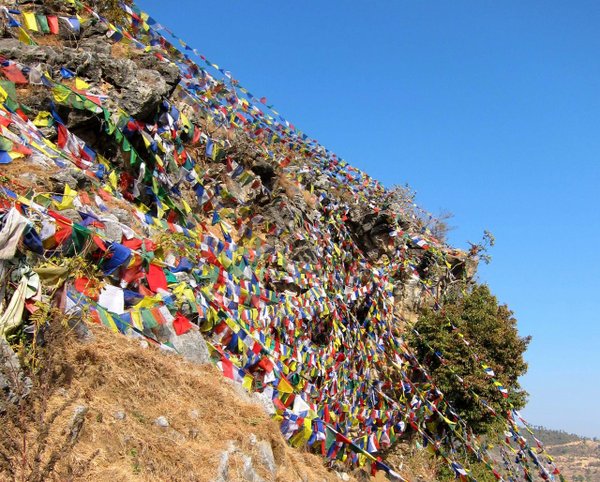
Prayer flags festoon the secret cave on Manjushri Hill where Rinpoche did retreat with Dagri Rinpoche and Khadro-la. Photo by Ven. Sarah Thresher.
Lama Zopa Rinpoche himself has twice been to Maratika for retreat ‒ the first time on the advice of Kyabje Trulshig Rinpoche ‒ and there is a short video on YouTube with clips from the last trip with Khadro-la and Dagri Rinpoche.
I’ve been four times to Maratika to do prayers for Rinpoche’s long life over the past seven years, but this was my first time to go during the first 15 days of Losar when merits multiply many millions of times. It was Rinpoche’s advice to go at this time when the offerings would be most powerful but, of course, it was also the most challenging time!
Rinpoche himself also sent an offering for the nuns. This year there were three separate prayer festivals (monlams) being held at Maratika during Losar. The first was organized by Maratika Monastery during the first four days of Losar. We arrived just in time to join this festival and offered the first 10,000 butter lamps during these four days as well as lunch and tea to all the Sangha.
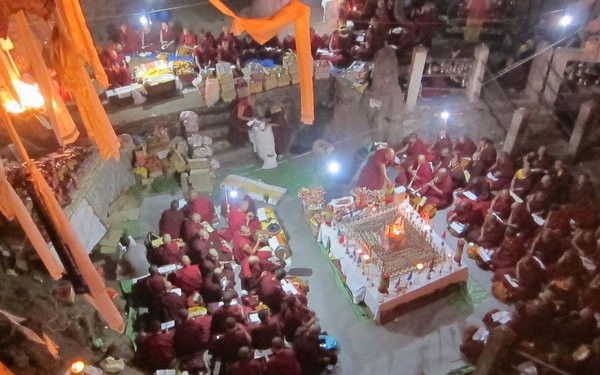
Hundreds of offering were made during Losar and surrounded the main altar to Namgyalma. Photo by Ven. Sarah Thresher.

Ven. Sarah Thresher at Maratika Caves, February 2013
I made many thousands of light offerings throughout the Losar period along with other offerings with prayers and dedications for Rinpoche’s long life and fulfillment of all Rinpoche’s wishes. I always felt that I was representing all who have offered me support and I am extremely grateful for being given this precious opportunity to do prayers for our Guru. I hope that in this way all of your own prayers and wishes will be fulfilled. Please as you read this, also dedicate for Rinpoche to have a long and stable life.
You can learn more about Maratika by visiting the website for Maratika Monastery www.maratika.org.
Ven. Sarah Thresher is a senior English nun, a FPMT registered teacher and frequent contributor to Mandala. She is also editor of Lama Yeshe Wisdom Archive’s Heart Advice Series.
- Tagged: mandala, maratika cave, pilgrimage, ven. sarah thresher
- 0
22
Chokyi Gyaltsen Center Hosts Jade Buddha for Universal Peace in Penang
FPMT News Around the World
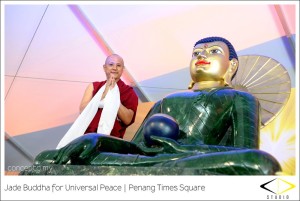
Geshe Deyang, one of Chokyi Gyaltsen Center’s resident teachers, with the Jade Buddha at Penang Times Square, Malaysia, April 2013. Photo by conceptd (conceptd.my/blog/).
The Jade Buddha for Universal Peace recently wrapped up its April showing at Penang Times Square, a shopping complex in Penang, Malaysia. The visit was organized by FPMT group Chokyi Gyaltsen Center and co-organized with Buddhist Societies in Northern Malaysia.
“It has been the most amazing nine days,” reflected center director Daniel Yeoh in a public message. “What is more rewarding is to see 100,000 people coming here to make rice, light, and flower offerings [to the Jade Buddha statue], viewing the phenomenally beautiful Medicine Buddha sand mandala, and the ever-long queues for the relics blessings. You can see everyone who come here was filled with joy and the curious mind of wanting to know more about Dharma. It was a moment where our minds found no space for negative thoughts or non-virtuous thoughts. No wonder the energy at the Jade Buddha site was so strong.”
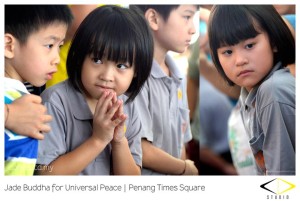
Hundreds of school children visited the Jade Buddha by bus, Penang Times Square, Malaysia, April 2013. Photo by conceptd (conceptd.my/blog/).
At the instruction of Lama Zopa Rinpoche, the four-ton gemstone quality Jade Buddha has been touring worldwide. Since March 2009, the statue has visited 66 cities around the world and blessed nearly 7 million people. The Jade Buddha is scheduled to exhibit next in Korea, Japan and Macau.
More photos from the Penang event can be found on Chokyi Gyaltsen Center’s Facebook page.
If you like what you read on Mandala, consider becoming a Friend of FPMT, which supports our work. Friends of FPMT at the Basic level and higher receive the print magazine Mandala, delivered quarterly to their homes.
- Home
- News/Media
- Study & Practice
- About FPMT Education Services
- Latest News
- Programs
- New to Buddhism?
- Buddhist Mind Science: Activating Your Potential
- Heart Advice for Death and Dying
- Discovering Buddhism
- Living in the Path
- Exploring Buddhism
- FPMT Basic Program
- FPMT Masters Program
- FPMT In-Depth Meditation Training
- Maitripa College
- Lotsawa Rinchen Zangpo Translator Program
- Universal Education for Compassion & Wisdom
- Online Learning Center
- Prayers & Practice Materials
- Overview of Prayers & Practices
- Full Catalogue of Prayers & Practice Materials
- Explore Popular Topics
- Benefiting Animals
- Chenrezig Resources
- Death & Dying Resources
- Lama Chopa (Guru Puja)
- Lama Zopa Rinpoche: Compendium of Precious Instructions
- Lama Zopa Rinpoche: Life Practice Advice
- Lama Zopa Rinpoche Practice Series
- Lamrim Resources
- Mantras
- Prayer Book Updates
- Purification Practices
- Sutras
- Thought Transformation (Lojong)
- Audio Materials
- Dharma Dates – Tibetan Calendar
- Translation Services
- Publishing Services
- Teachings and Advice
- Find Teachings and Advice
- Lama Zopa Rinpoche Advice Page
- Lama Zopa Rinpoche: Compendium of Precious Instructions
- Lama Zopa Rinpoche Video Teachings
- ༧སྐྱབས་རྗེ་བཟོད་པ་རིན་པོ་ཆེ་མཆོག་ནས་སྩལ་བའི་བཀའ་སློབ་བརྙན་འཕྲིན།
- Podcasts
- Lama Yeshe Wisdom Archive
- Buddhism FAQ
- Dharma for Young People
- Resources on Holy Objects
- Ways to Offer Support
- Centers
- Affiliates Area
- Teachers
- Projects
- Charitable Projects
- Make a Donation
- Applying for Grants
- News about Projects
- Other Projects within FPMT
- Support International Office
- Projects Photo Galleries
- Give Where Most Needed
- FPMT
- Shop
Subscribe to FPMT News
Translate*
*powered by Google TranslateTranslation of pages on fpmt.org is performed by Google Translate, a third party service which FPMT has no control over. The service provides automated computer translations that are only an approximation of the websites' original content. The translations should not be considered exact and only used as a rough guide.Living in morality is one fundamental spiritual practice that is a very important source of happiness for you and for all living beings. This is also one of the best contributions that you can give to this world, for world peace.







